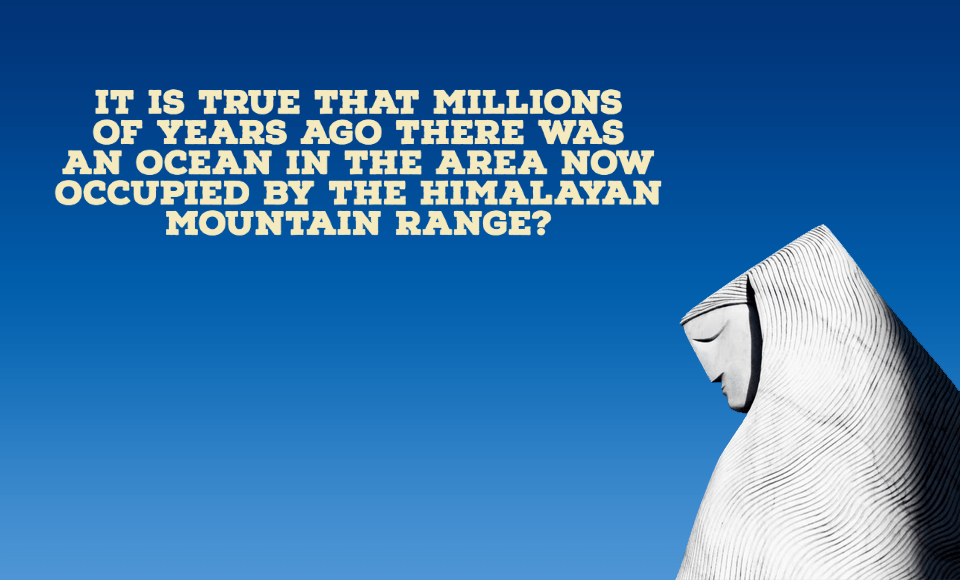The Himalayas stretching across the northeastern part of India covers approximately 1,500 mi (2,400 km) and passes through India, Pakistan, Afghanistan, China, Bhutan, and Nepal. Three parallel ranges comprise the Himalayan Range, often referred to as the Greater Himalayas, the Lesser Himalayas, and the Outer Himalayas.
It has over fifty mountains exceeding 7,200 m (23,600 ft) in elevation, including ten of the fourteen 8,000-meter peaks where the well-known highest mountain, Mt. Everest, belongs.
About 52.7 million people are living in the Himalayas, spread across five countries: Bhutan, China, India, Nepal, and Pakistan.
Despite the beauty of the mountain range that we see, Himalayas was once a sea.
About 70 million years ago, the Indo-Australian plate collided into the underbelly of the Eurasian plate that gave birth to the Himalayas’ geological marvel. A complex structure of misshaping of the lithosphere had taken place due to the continental collision.
The Tethys Sea once existed in the location. However, it disappeared as the Indian landmass continued to thrust into Asia. The sediments at the bottom of the sea were pushed up in a series of gigantic folds of the Earth’s lithosphere and reached 8850m high, straight from sea level.
The Tethys Sea was an ocean that existed about 250 million years ago during the Mesozoic Era (Geological time). It divided the one large piece of land called “Pangaea” into two super large continents known as Laurasia and Gondwana. It was named after the mythological Greek Sea Goddess known as Tethys, a sister, and consort of Oceanus. Oceanus is the mother of the world’s great water bodies such as rivers, lakes, and fountains. It was also into two-part based on geological time and continental position.
The Tethys Seas was named based on the year or era in which it existed. The first Tethys Sea was called “Paleo,” meaning old because it formed 320 million years ago in the late “Paleozoic Era.” At that period, all landmasses converged to create a big super giant continent of “Pangaea.”
The second Tethys sea is Neotethys (New or young), commonly referred to as the Tethys Sea formed during the splitting of great continent Pangaea in two parts – Laurasia and Gondwana.
The Himalayas are still rising, which makes the area geologically unstable and seismically active since the Indo- Australian plate is still moving-at 67 mm each year. And for the next 10 million years, it will move 1,500 kilometers forward into Asia.
One crucial influence of Himalayas’ history is its profound significance for the people of South Asia. It has a significant part of their literature, mythologies, and religions reflect for a thousand years. Since ancient times the vast glaciated mountain ranges have attracted the attention of India’s pilgrim mountaineers who coined the Sanskrit name Himalaya—from Hima, meaning “snow” and Alaya meaning “abode”—for that great mountain system. Today, the Himalayas have offered the wondrous attraction and the greatest challenge to mountaineers throughout the world.
Meanwhile, there were reports about residents in the northern Indian state of Punjab telling they have seen the Himalayan mountain range for the first time after 30 years due to a drop in air pollution caused by the country’s COVID-19 lockdown. Indians were proud and happy sharing photos of the Himalayas on Twitter, saying the mountain range could be seen from more than 100 miles away.
(https://www.insider.com/himalayas-seen-from-india-pollution-drop-coronavirus-lockdown-2020-4)
Fast Facts:
- The Himalayas are the planet’s one of the youngest mountain ranges.
- Due to the tremendous amount of tectonic motion occurring at the site, the Himalayas have a high number of earthquakes and tremors.
- The Himalayas cover approximately 75% of Nepal.
- The air and water circulation systems are affected by the range, impacting the weather conditions in the region.
- The range served as a natural barrier for tens of thousands of years and prevented early interactions between India and the people of China and Mongolia.
- Mt. Everest got its name from a British surveyor, Colonel Sir George Everest, who was based in India during the early-to-mid-nineteenth century.
- Mt Everest is called “Sagarmatha,” by the Nepalese, which means “Goddess of the Universe” or “Forehead of the Sky.”
- In 1953, Sir Edmund Hillary and Sherpa mountaineer Tenzing Norgay were the first people to climb to the summit of Everest successfully.
